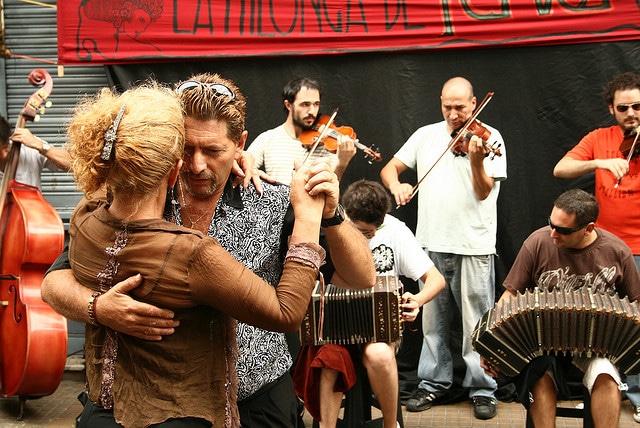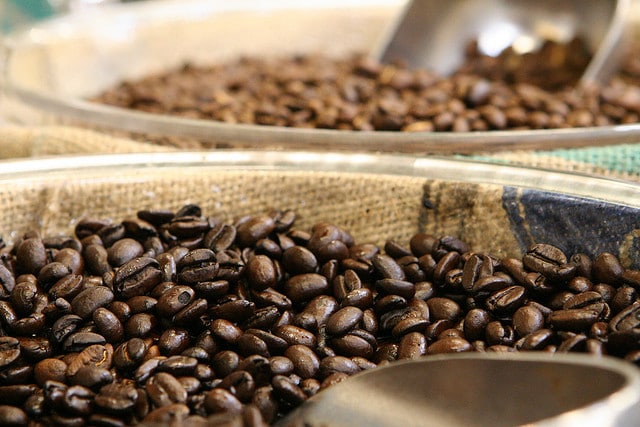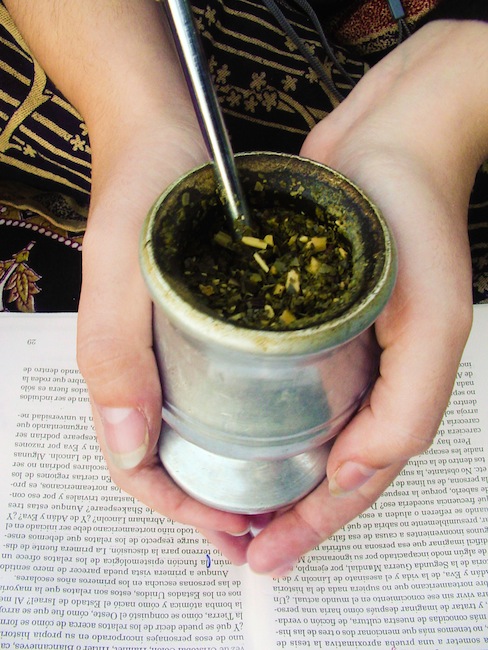
As an avid hiker and outdoor enthusiast, my travel itineraries tend to feature less time spent in cities and more time in rural communities and near the mountains. In fact, when traveling through Argentina I expected to spend very little time in the capital of Buenos Aires.
Feria de San Telmo
It probably didn’t help my growing attachment that I started my visit on a Sunday. You see, while other cities sleep at the end of the weekend, Buenos Aires is at its liveliest. There are just so many things to do in Buenos Aires. Sunday is when you’ll find markets and fairs littered all over the city, the most notable one being the Feria de San Telmo.
San Telmo is known for having a large selection of antiques, and the fair showcases endless stalls and storefronts selling ancient Japanese swords, old soda bottles, vintage telephones, antique cutlery, old dollars and more. Not only that, but you can purchase high-end liquors and local artwork from all different disciplines.
What really captivated me about the market was the ambiance. While locals and tourists alike excitedly browsed the myriad offerings for purchase, sexy tango dancers performed fiery ensembles that made me both blush and applaud. And on the corner of Calles Mexico and Defensa my ears were not only captivated by traditional folklore music being played live, but also a street barbecue of juicy choripan, plump and flavorful chorizo sausages topped with condiments like ketchup, mustard, mayo and chimichurri. Each bite sent pork juice and sauerkraut dribbling down my chin, a truly epicurious experience enhanced by the magic fingers of the local guitar player.

Learning To Tango
After watching the sensual, passionate moves of the tango dancers in San Telmo I didn’t want to simply see a tango show like the other tourists, I wanted to learn to tango. Luckily, a local friend was able to put me in touch with a man named Juan who has global choreographing experience willing to give me a private lesson.
“Tango is a partner dance, so you’ll need to read your partners body which will tell you how to move as a response,” explains Juan.
As someone who gets weirded out by holding hands, I knew this would be a bit of a struggle; however, after seeing the languid, flowing bodies and beautiful moves of the tango dancers from the fair I was now on a mission. I wanted to learn to dance tango — and well enough that if a handsome local asked me for an impromptu dance in the park I wouldn’t embarrass myself.
Juan opens a bottle of Malbec. “Wine is also a big part of the tango experience. Having a glass can help loosen you up.”
I take a few sips, willing it to hit my brain fast and turn me into carefree and graceful performance artist — or at least get rid of my ability to care. There’s no time, however, as Juan wants to get right down to work. He begins by explaining an important part of the dance is having a natural embrace with your partner, holding each other securely but allowing for movement.
Dancers use this and the music to help form a connection, another vital piece in the puzzle that is a good tango dance. He teaches me the “tango walk” — a sequence of steps meant to help us walk in line together — adjusts my posture a few times to have a strong confident core and straight spine, and makes sure I keep eye contact, even when I feel awkward.
It takes me about five tries (or maybe 30) until I am feeling somewhat confident. I’m not sure if it’s just the wine making me get a big head when Juan suddenly turns to me. “Do you have family from Argentina? I can tell you you have some Latin blood in you.”
While I did not have any Latin blood, I was happy for the compliment. Maybe I would be able to bring some of the culture home and tango with my friends when we’re out dancing. Although I know this probably won’t happen, I do smile at the thought of allowing some Argentinian culture to work its way into my veins. I may not have been born with Latin blood but I would try to make some.

Local Coffee Culture
Dance isn’t the only thing Portenos — a nickname for locals of Buenos Aires — are passionate about, as the city is home to a strong coffee culture. In fact, 53 of the city’s oldest cafes are registered as culture and heritage landmarks of the city. I decide to explore this facet of the local culture at Argentina’s oldest coffee shop, Cafe Tortoni.
Established in 1858, Cafe Tortoni will transport you to the roots of Argentine coffee culture. The tattered walls, antique furniture, silver platters and traditional artwork add old world charm while newspaper clippings and artifacts allow you to learn more about the cafe. While the decor is dated in a whimsical fashion, the menu offers updated and artisanally-crafted selections.
While I’m used to enjoying my coffee in the morning, Cafe Tortoni doesn’t open until 5pm, with locals going there in the evenings to enjoy a pre-dinner snack. As dinner isn’t typically eaten until 10pm or later, coffee and biscuits can provide a nice energy jolt.
Not surprisingly, the strong coffee culture of Buenos Aires comes with its own way of ordering:
- To order a small espresso shot, make a “c” shape with your hands (shown above). You don’t even need to say anything, although if you want to say “cafe” while doing the gesture.
- If you’d like something bigger that contains 3/4 coffee and 1/2 milk, say “jarito.”
- To order a cup with 3/4 milk and 1/4 coffee, tell your waiter “lagrima.”
- If you say “cafe con leche,” this means you want a big cup containing 1/2 milk and 1/2 coffee.

Artistic Immersion
Bursting with art-inspired accommodations, creative cafes, graffiti tours, passionate street art, art museums and boutique galleries, Buenos Aires is an immersive art experience in itself. Simply strolling the streets — especially in neighborhoods like San Telmo and Palermo — will make you feel like you’re wandering through a museum without walls as you take in endless murals and street paintings.
While in New York I was used to seeing names and markings haphazardly sprayed onto brownstone walls, the works in Buenos Aires were thought-provoking and full of emotion. After spending a few days in the city it isn’t hard to figure out why. Here at least one protest happens per day, especially in front of the Casa Rosada on Plaza de Mayo and down Avenida de Mayo. These locals are opinionated, especially when it comes to politics, and will express themselves in any way they can.
For those interested in a more structured art experience, there’s an endless amount of creative institutions, like the National Museum of Decorative Arts, National Museum of Fine Arts and Museum of Latin American Art of Buenos Aires. One truly local art experience is heading to Hollywood in Cambodia, a bar and urban art gallery in one.
The space was opened in 2006 when the owners of Post Street Bar decided to do something creative and began approaching stencil artists to help them decorate the inside of the venue. Because the owners didn’t have the money, they offered the artists three rooms at the back of the bar, rent free, to use however they pleased. From there, the artists covered every inch of the bar and terrace with intricate stencil art, free from any commercial pressure or influence. One room became a permanent gallery and shop, and the two others were transformed into temporary exhibition spaces. This is what visitors can experience today.
What’s really interesting when you walk into the space is how hard it is to tell where the gallery starts and where the bar stops. All of the bar space – the outside walls, terrace and even the toilets – have been covered in art. This is because the artists use the bar as an extension of the gallery space, running workshops and video screenings. Understandably, the bar ends up being a popular place to hangout for the artists and their friends. In fact, exhibition opening nights showcasing cutting edge art often end up becoming wild parties.

Making Connections Through Mate Drinking
It is at Hollywood in Cambodia that I meet Javiar, a born-and-raised Porteno who introduces me to another important cultural facet, mate. Anyone who has ever visited Argentina has seen locals walking around with open-metal cups with long metal straws. Upon first glance I had assumed they were drinking tea; however, they were actually drinking mate.
Mate is a blend of You’re drinking yerba mate leaves with caffeine, herbs, protein and hot water The “metal cup” is actually veneered wood called a mate, while the long metal straw is called a bombilla. Along with drinking the concoction for a boost of energy it also provides a very social aspect to the culture, giving locals an excuse to get together and pass around some mate.
Drinking the mate is almost like a ceremony. The one who prepares it takes the first taste before passing it on to the next person until they say “thank you,” which means they are finished. It reminds me of watching my pothead roommates in college smoke with random strangers in our living room and pass joints around, making new friends without question. There was a sense of community they seemed to form, which is what seems to be happening with the mate.
The drink smells pungent, and I wince for a quick second when I try it for the first time. I don’t want to be rude though – and I am interested to see what all the hype is about – so I sip. Javier notices my face twist in agony and runs to grab some sugar.
“Add this,” he advises. “It can be pretty bitter, especially if you’ve never had it before.”
We pass the mate around again, this time with the sugar added. When it comes back to me, I don’t say thank you but simply take the cup. I know better than to take a whiff this time and just go for it. While the drink is still bitter, it’s much better than last time. And, as the mate keeps going around the circle, it gets better and better. We sit for hours, playing board games, laughing and talking about the differences between American and Argentine culture.
“In New York I don’t think I’ve ever known anybody to have friends over on a weekend night just to hangout and drink anything that wasn’t beer or liquor,” I say. “Maybe I’ll be the first when I get home.”
I smile to myself, thinking about how nice it would be to bring some of this beautiful Argentinian culture home.

The Logistics
Art Accommodations: Those looking for a more upscale experience should book a room at A Hotel. Located in Recoleta in a restored historical townhouse, A Hotel (the “A” stands for “art”) features a first-floor art gallery and guestrooms filled with drawings, paintings, photographs and sculptures by local artists.
Local Fairs and Markets: Fairs and markets abound in Buenos Aires, providing a great way to peruse local handicrafts and artwork, take in a free and al fresco tango show, hear live music, and sample typical delicacies. The most popular of these fairs is the Feria de San Telmo, held on Sundays from 10 am to sundown, which focuses on antiques, art and quirky finds.
You’ll also see live tango and street performances. On Saturdays and Sundays you’ll find an artisanal fair in Plaza Francia near Recoleta Cemetery, with over 100 stalls of traditional pottery, leather products, traditional foods and street performers. In the Palermo Soho area, you’ll find numerous markets, like the one at Plaza Serrano, which has a hippie vibe and is great for finding unusual clothing items and alternative jewelry. You can also stop by Plaza Armenia for handmade goods, keepsakes and clothing.
Tango Lessons: For those looking to learn the art of tango, Buenos Aires features numerous options, some of which include La Academia de Susana Miller, Escuela Argentina de Tango and Classes with Cacho Dante. Many of the city’s cultural centers also offer lessons on Sundays.
Street Art: There are many options for those who want to learn more about local art. We recommend taking a graffiti tour with Graffitimundo, where you’ll not only see interesting street art but also learn about the artists and the meanings behind the works.
Coffee Shops: The above mentioned Cafe Toronti is located at Avenida de Mayo 825. Another great cafe in Buenos Aires is EL Gato Negro (Avenida Corrientes 1669), featuring walls lined with spices, exotic teas and coffees and has a coffee salon vibe with a variety of high quality coffee beans. There’s also Establecimiento General (Avenida Pueyrredon 1529), which has over 30 different coffee varieties served in both traditional and non-traditional ways.
Top photo: Dancers and musicians at Feria de San Telmo. Photo courtesy of Pablodda.

Jessica Festa is the editor of the travel sites Jessie on a Journey (http://jessieonajourney.com) and Epicure & Culture (http://epicureandculture.com). Along with blogging at We Blog The World, her byline has appeared in publications like Huffington Post, Gadling, Fodor’s, Travel + Escape, Matador, Viator, The Culture-Ist and many others. After getting her BA/MA in Communication from the State University of New York at Albany, she realized she wasn’t really to stop backpacking and made travel her full time job. Some of her most memorable experiences include studying abroad in Sydney, teaching English in Thailand, doing orphanage work in Ghana, hiking her way through South America and traveling solo through Europe. She has a passion for backpacking, adventure, hiking, wine and getting off the beaten path.








